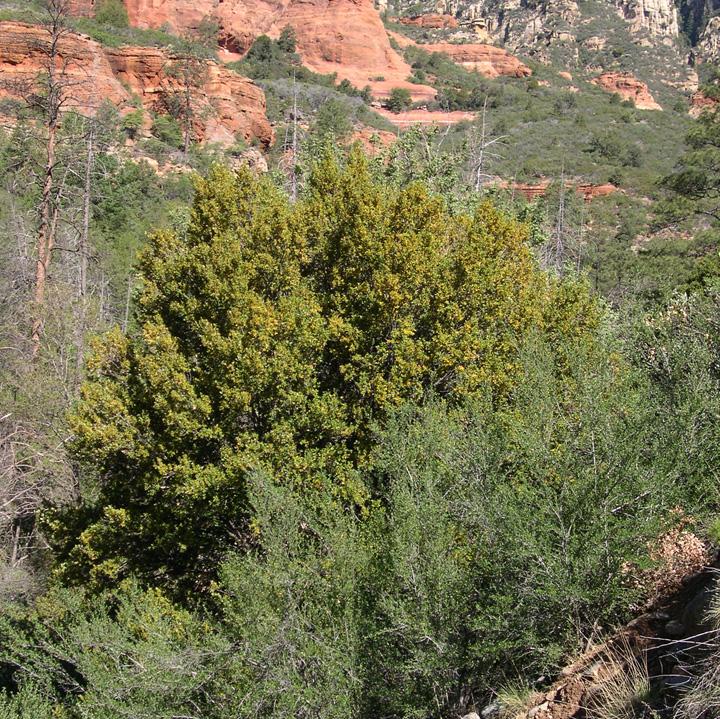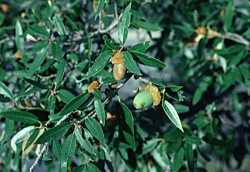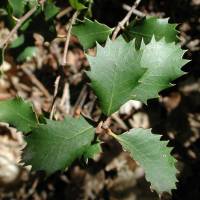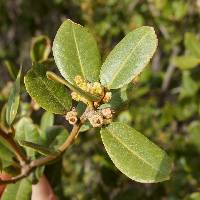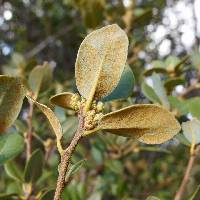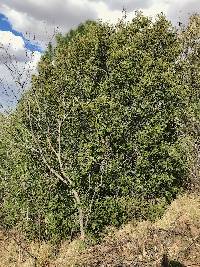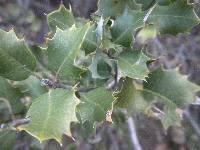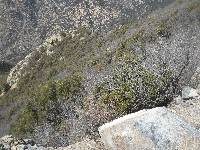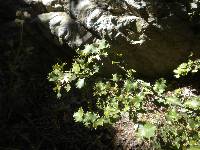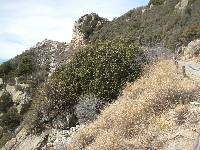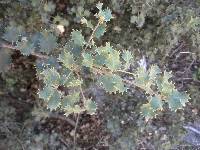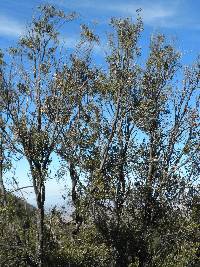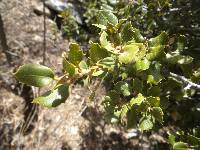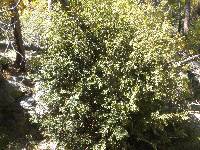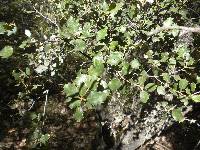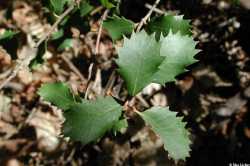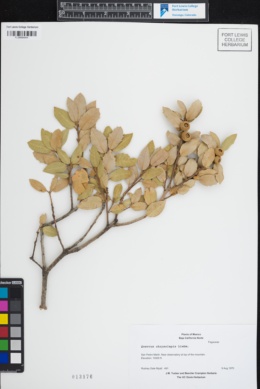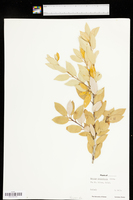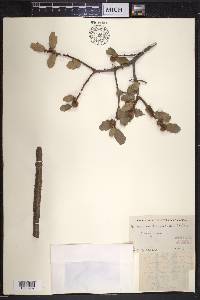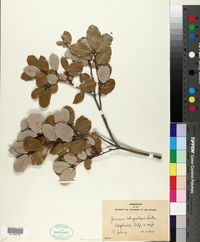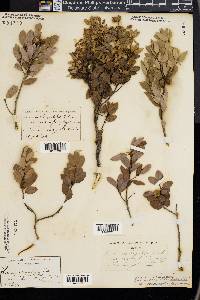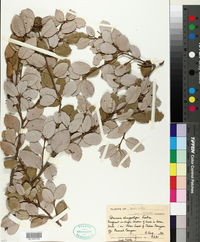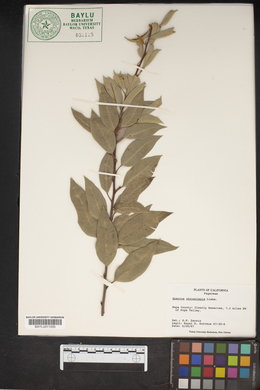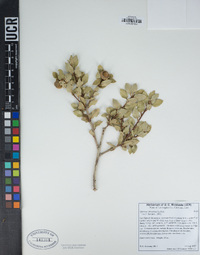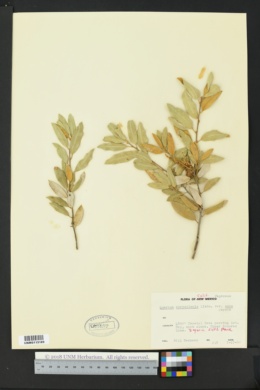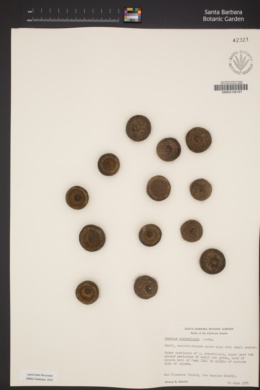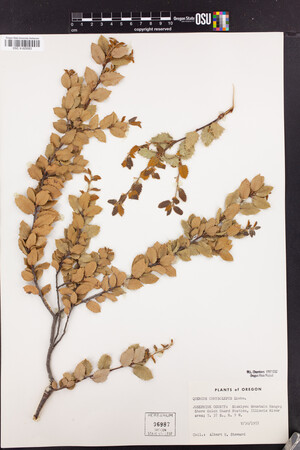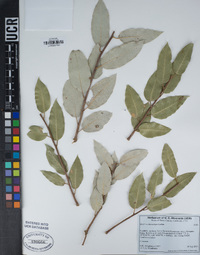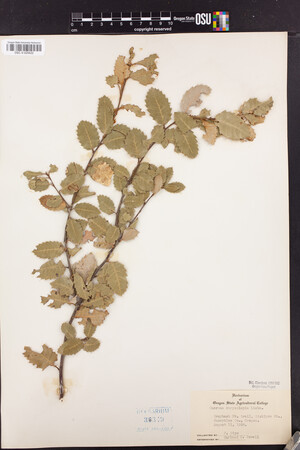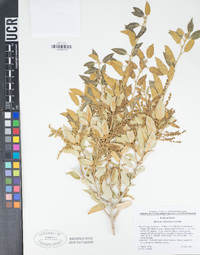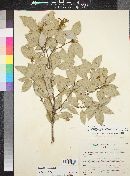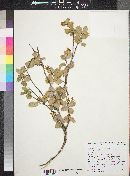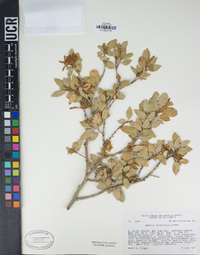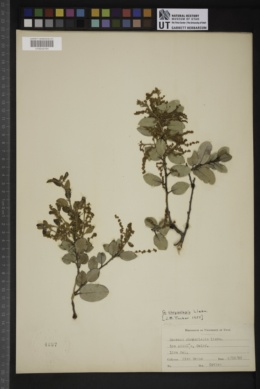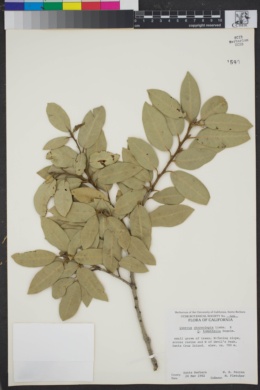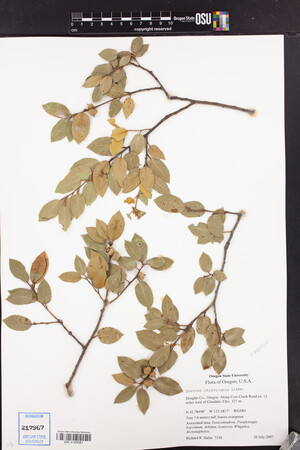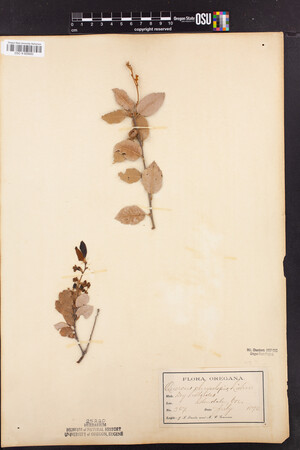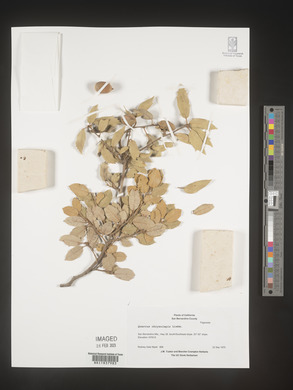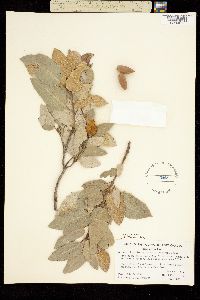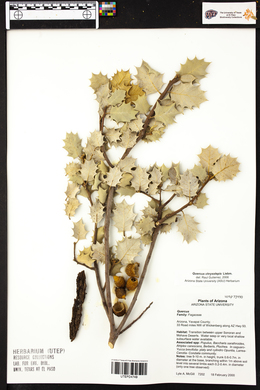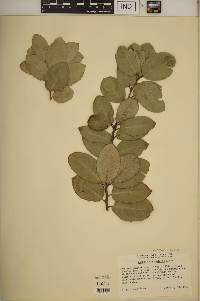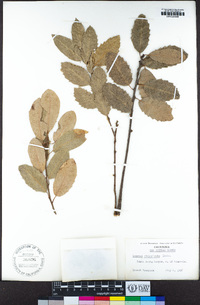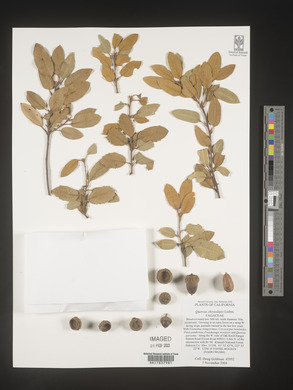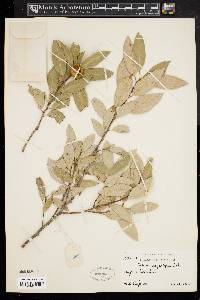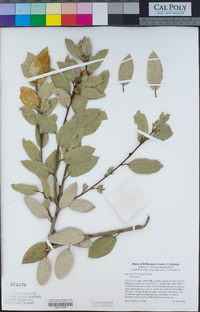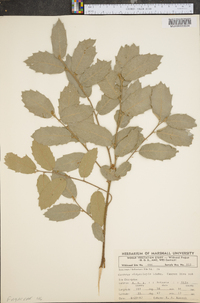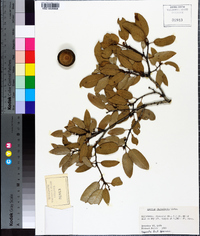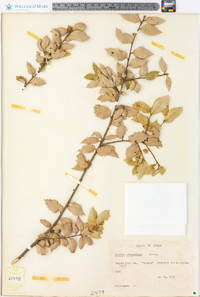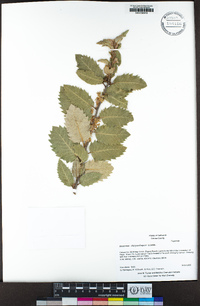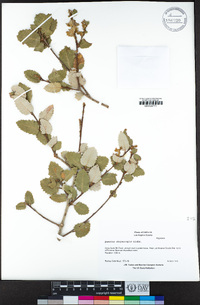Quercus chrysolepis
|
|
|
|
Family: Fagaceae
Canyon Live Oak, more...golden oak (es: encino roble)
[Quercus chrysolepis f. grandis Jeps., moreQuercus chrysolepis f. pendula Jeps., Quercus chrysolepis var. hansenii (Jeps.) Jeps.] |
Trees or shrubs , trees small to medium-sized, to 25 m, shrubs of variable size. Twigs branching at 60° angles or less, golden brown, 1-2 mm diam., flexible, densely pubescent 1st year, moderately so 2d year. Terminal buds conic, 2-8 mm, scales brown with ciliate margins. Leaves: petiole 3-14 mm, rusty-pubescent, adaxially flattened. Leaf blade oblong, acuminate, usually flat to slightly concave, 20-70 × 10-35 mm, thick, leathery, base obtuse to rounded, secondary veins 12 or more pairs, branching at ca. 50° angles, slightly raised abaxially, margins often slightly revolute with moderately thickened cell walls, entire to spinulose-dentate (especially on juvenile growth), regularly toothed, teeth terminating with mucronate to spinescent tip, apex acute or obtuse, mucronate to spinescent; surfaces abaxially glabrate to pubescent with bluish white wax layer, often obscured by golden glandular and multiradiate hairs, adaxially yellowish green, scurfy with multiradiate hairs, later in season slightly pubescent. Acorns solitary or paired, rarely in 3s or 4s; cup saucer-shaped, 4-10 mm deep × 15-40 mm wide, rims often corky and thickened, scales appressed, deeply embedded in tomentum, often appearing swollen and keeled, tuberculate; nut ovoid, 15-30 × 10-20 mm, apex blunt, glabrous; nut scar 4-10 mm diam. Flowering usually in spring, occasionally in fall. Mountain ridges, canyons, and moist slopes; 200-2600 m; Ariz, Calif., Nev., N.Mex., Oreg.; Mexico (Baja California and Chihuahua). Quercus chrysolepis is one of the most variable North American oaks. Historically, individuals with extreme variation in fruit and leaf characteristics led to the recognition of several varieties and forms; for example, shrubs with small leaves have been called Q . chrysolepis var. nana (Jepson) Jepson. Studies of quantitative and qualitative variation in these characteristics do not support the recognition of infraspecific taxa; geographic variation is apparent, however, based on populations with nearly stabilized character combinations that loosely define widespread variants. This oak is distinguished consistently from other species of the complex by the presence of multiradiate trichomes on both leaf surfaces (P. S. Manos 1993). The leaf morphology and branching habit present on juvenile growth, suckers, and shade forms may approach typical Q . palmeri . Similarly, various extreme forms often resemble other species of the complex. Putative hybrids have been reported from narrow zones of range overlap with the three other North American species of Quercus sect. Protobalanus . The Mendocin Indians considered the nuts of Quercus chrysolepis poisonous (D. E. Moerman 1986).
Plant: shrub or tree to ca. 10 m high; bark smooth or rough, dark gray, the young growth often covered with orangeish glandular hairs; young twigs densely to sparsely woolly, smooth reddish-brown beneath tomentum, the older twigs glabrescent, gray, often blackened, the bark exfoliating in thin filaments or scales Leaves: unlobed (sometimes deeply serrate), ovate, elliptic, lanceolate, or suborbicular, 1-4.3 cm long, 0.7-3.1 cm wide, 1.2-3 times as long as wide, often covered with orangeish glandular hairs below when young, the mature leaves glabrous to subglabrous with few or no glandular hairs, covered with whitish wax below, lustrous dark green above, drying light gray above, persisting about 3 years; stellate hairs of lower leaf surface few, with 4-8 arms; apex acute or acuminate, often mucronate; base rounded to obtuse; petiole 3-10 mm long; midvein flat to slightly raised above, prominent below; lateral veins 10-15 pairs, ascending, indistinct or faint above, faint to moderately strong below; secondary venation indistinct; blade coriaceous; margin slightly revolute, usually entire but sometimes with 1 to several attenuate, spinose, mostly ascending teeth INFLORESCENCE: staminate flowers in aments; pistillate flowers solitary or in groups on spikes, these sometimes abbreviated, each pistillate flower with a separate involucre Flowers: mostly wind-pollinated, unisexual, the perianth much reduced or absent; staminate flowers in heads or aments, the perianth greenish, the stamens ca. 7-9; pistillate flowers usually tricarpellate, solitary or in clusters of about 3 or more, subtended individually or in groups by an involucre that develops into a woody cupule enclosing or subtending the mature fruit(s) Fruit: ACORNS 2-2.5 cm long; cap usually saucer-shaped, slightly thickened and woody, 5-7 mm long, 14-18 mm wide, often with yellow glandular hairs without, densely covered with stiff, straight hairs within; scales with thickened bases; nut-shell subglabrous except for patches of tomentum within Misc: In riparian and conifer forests, and in exposed rocky areas; 1050-2350 m (3500-7800 ft); May (fr. Aug-Sep) REFERENCES: Landrum, Leslie R. Fagaceae. 1994. J. Ariz. - Nev. Acad. Sci. Volume 27, 203-214 Landrum 1993 Common Name: canyon live oak Duration: Perennial Nativity: Native Lifeform: Tree General: Shrubs and trees that can reach 10 m high, the bark is smooth to rough, and exfoliates in thin filaments or scales. Leaves: Unlobed to deeply serrate, varies from ovate to lanceolate and suborbicular, 1-4 cm long and 1-3 cm wide, 1-3 times as long as wide, with orange-ish glandular hairs on the underside when young, whitish waxy when mature, upper surface lustrous dark green drying light green, apex often mucronate, base rounded to obtuse on a 3-10 mm long petiole and prominent vein below, slightly revolute margin. Flowers: Aments with staminate flowers and pistillate lowers solitary or in groups on spikes. Fruits: Acorn in cupule that is thickened and woody, the acorn 2-2.5 cm long, the cupule 5-7 mm long, less than 2 cm wide all together. Ecology: Found in riparian and conifer forests and in exposed rocky sites from 3,500-8,000 ft (1067-2591 m), flowers in May and fruits in August to September. Distribution: Ranges across Arizona, North to Oregon and south into northwestern Mexico. Notes: Similar in appearance to Q. dunnii but distinguished by the serrate margins as opposed to the spinose toothed margins. The acorns also lack the flared margins on the cupule and this species is generally found as a tree above 6,000 ft (1829 m). Ethnobotany: While some tribes considered the acorns poisonous, others used it for dried food, for meal to make bread and mush and gruel, they were generally leached and cooked or made into flour. The trees were used for all manner of tools and fuelwood, and some even used the acorns like small toys. Etymology: Quercus is the classical Latin word for oak, thought to be derived from Celtic quer, fine, and cuez, tree, from the Greek meaning golden-scaled, referring to the underside of the leaves. Synonyms: Quercus chrysophyllus, Quercus crassipocula, Quercus fulvescens, Quercus wilcoxii Editor: SBuckley 2012 |
|
|
|

